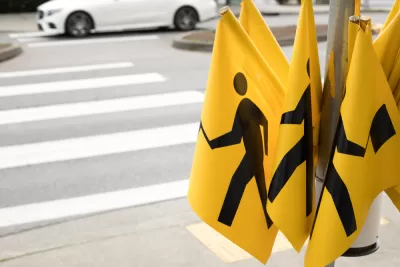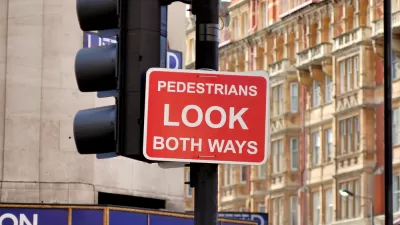One common scapegoat for rising pedestrian death rates is "distracted walking." But there is little reason to believe that smartphone-wielding pedestrians are a major cause of roadway carnage.

As I have mentioned in an earlier blog post, the number of pedestrians killed by cars and trucks in the United States has increased by 50 percent over the past decade. One common excuse for doing nothing about this problem is to blame the victim: in particular, to claim that the real problem is "distracted pedestrians." According to this theory, pedestrians are dying in large numbers because the victims are too busy looking at their phones to notice oncoming vehicles.
But this theory does not explain the growth of pedestrian fatalities, for three reasons. First, there is no evidence that deaths involving distracted walking cause a significant amount of deaths. For example, one 2014 article in Governing begins with the hysterical headline, "Too Many Pedestrians Injured By Looking At Their Phones." From that headline, you might think that thousands of pedestrians have been killed while texting. But the article itself states that the federal government attributes only half a dozen deaths to electronic devices.
Second, pedestrian injuries disproportionately affect low-income and elderly walkers, who are less likely to own smartphones. According to the Pew Research Center, only 53 percent of persons over 65, and 71 percent of persons earning under $30,000, own smartphones; by contrast, over 90 percent of persons under 29 and persons earning over $75,000 per year own smartphones. If smartphones were a major cause of the problem, younger and more affluent Americans would be more likely to be victimized by speeding cars.
Third, smartphone use is just as common in European nations as it is in the United States; smartphone use is higher in Sweden and the Netherlands than in the United States, and almost as high in France and England. According to Pew, 81 percent of U.S. adults own a smartphone, compared to 87 percent of Dutch, 86 percent of Swedes, 78 percent of Germans, 76 percent of British, and 75 percent of French. If distracted walking were such a major problem, European traffic deaths would have risen at the same time American traffic deaths have risen. But, in fact, European traffic deaths have declined by over a third over the past decade, while American traffic deaths have risen. So the link between smartphones and pedestrian crashes is at best unproven, and at worst very weak.

Maui's Vacation Rental Debate Turns Ugly
Verbal attacks, misinformation campaigns and fistfights plague a high-stakes debate to convert thousands of vacation rentals into long-term housing.

Planetizen Federal Action Tracker
A weekly monitor of how Trump’s orders and actions are impacting planners and planning in America.

In Urban Planning, AI Prompting Could be the New Design Thinking
Creativity has long been key to great urban design. What if we see AI as our new creative partner?

King County Supportive Housing Program Offers Hope for Unhoused Residents
The county is taking a ‘Housing First’ approach that prioritizes getting people into housing, then offering wraparound supportive services.

Researchers Use AI to Get Clearer Picture of US Housing
Analysts are using artificial intelligence to supercharge their research by allowing them to comb through data faster. Though these AI tools can be error prone, they save time and housing researchers are optimistic about the future.

Making Shared Micromobility More Inclusive
Cities and shared mobility system operators can do more to include people with disabilities in planning and operations, per a new report.
Urban Design for Planners 1: Software Tools
This six-course series explores essential urban design concepts using open source software and equips planners with the tools they need to participate fully in the urban design process.
Planning for Universal Design
Learn the tools for implementing Universal Design in planning regulations.
planning NEXT
Appalachian Highlands Housing Partners
Mpact (founded as Rail~Volution)
City of Camden Redevelopment Agency
City of Astoria
City of Portland
City of Laramie






























